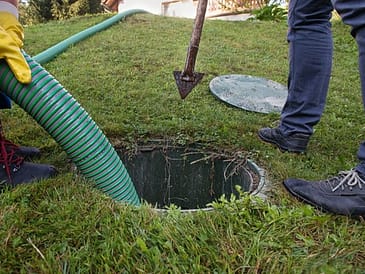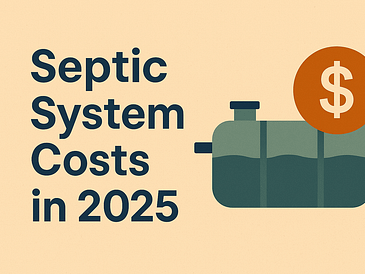The Ultimate Septic Tank Pumping Cost Guide: Everything Homeowners Need to Know in 2025
Don’t let a $500 maintenance job turn into a $15,000 nightmare – here’s what every homeowner must know about septic tank pumping costs before it’s too late.
Picture this: You wake up one morning to the horrifying smell of sewage backing up into your bathroom, raw waste pooling in your yard, and a repair estimate that makes your mortgage payment look like pocket change.
Sound like a homeowner’s worst nightmare?
It absolutely is – and it happens to thousands of families every year who thought they could skip “just one more year” of septic tank maintenance.
But here’s the reality check that could save you thousands: understanding septic tank pumping costs and maintenance isn’t just about avoiding disaster – it’s about protecting your home’s value, your family’s health, and your financial future. Whether you’re a first-time homeowner trying to decode septic system mysteries or a seasoned property owner looking to optimize your maintenance budget, this comprehensive guide will transform you from septic-confused to septic-savvy.
Understanding Septic Tank Pumping: The Foundation of System Health
Before diving into septic tank pumping cost factors, let’s establish exactly what septic tank pumping involves and why it’s absolutely critical for your home’s wastewater management system.
Septic tank pumping is essentially a deep cleaning process for your underground waste treatment facility. Think of your septic tank as a three-layer cake – but not the kind you’d want at a birthday party. The bottom layer consists of heavy sludge (solid waste that settles), the middle layer is liquid effluent, and the top layer is scum (oils, grease, and floating debris).
“Most homeowners don’t realize that septic tank pumping isn’t just about removing waste – it’s about preserving the bacterial ecosystem that breaks down solids. When you skip pumping, you’re not just risking overflow; you’re destroying the biological processes that keep your entire system functioning.” – Sarah Mitchell, Licensed Septic System Inspector with 15 years of experience
During professional septic tank pumping services, specialized vacuum trucks remove both the sludge and scum layers, leaving your tank ready to resume its vital waste processing functions. This process requires expertise, proper equipment, and adherence to environmental regulations – which directly impacts septic tank pumping pricing.
Average Septic Tank Pumping Costs: What to Expect in 2025
When researching septic tank pumping cost estimates, you’ll quickly discover that pricing varies significantly based on multiple factors. However, understanding the baseline costs helps you budget appropriately and identify when quotes seem unreasonably high or suspiciously low.
National Average Septic Pumping Costs
Across the United States, residential septic tank pumping costs typically range from $300 to $800, with the national average settling around $550 for a standard 1,000-gallon tank. However, these figures represent just the baseline service – additional factors can significantly impact your final bill.
For smaller tanks (500-750 gallons), expect to pay between $250-$450, while larger residential systems (1,500+ gallons) often cost $600-$1,200 to pump. Commercial septic tank pumping costs can range from $800-$2,500 depending on tank size and complexity.
Regional Septic Tank Pumping Price Variations
Geographic location plays a crucial role in determining septic tank pumping expenses. Rural areas with lower cost of living might see prices as low as $200-$350, while metropolitan areas and regions with strict environmental regulations can push costs to $700-$1,200 or higher.
Northeast states typically command premium pricing due to higher labor costs and stringent environmental compliance requirements. Southern and Midwest regions generally offer more competitive septic tank pumping rates, while Western states vary dramatically based on local regulations and market competition.
“I always tell homeowners to get at least three quotes for septic pumping, but don’t automatically choose the cheapest option. A company charging significantly below market rate might be cutting corners on disposal fees or proper waste handling – which could come back to haunt you later.” – Michael Rodriguez, Master Plumber and Septic System Specialist
Factors Affecting Septic Tank Pumping Costs
Understanding what influences septic tank pumping pricing helps you anticipate costs and potentially reduce expenses through strategic planning and system maintenance.
Tank Size and Capacity
Septic tank size directly correlates with pumping costs since larger tanks require more time, labor, and disposal capacity. Standard residential septic tank sizes include:
- 500-750 gallons: $250-$450 typical cost range
- 1,000 gallons: $350-$600 typical cost range
- 1,500 gallons: $500-$800 typical cost range
- 2,000+ gallons: $700-$1,200+ typical cost range
Accessibility and Location Challenges
Septic tank accessibility significantly impacts labor time and equipment requirements, directly affecting your affordable septic tank pumping options. Tanks located close to driveways with easy truck access represent the most cost-effective scenarios.
However, if your septic tank requires extensive digging to locate, sits far from vehicle access points, or requires specialized equipment to reach, expect additional charges of $100-$400. Some challenging situations that increase septic tank pumping costs include:
- Tanks buried deeper than standard depth (requiring extra excavation)
- Landscaping that must be temporarily removed or protected
- Limited access requiring smaller pumping trucks or portable equipment
- Steep terrain or unstable ground conditions
Tank Condition and Maintenance History
Neglected septic tanks often require additional time and specialized handling, increasing cheap septic tank pumping costs. Tanks that haven’t been pumped for extended periods may have:
- Excessive sludge buildup requiring multiple pump cycles
- Hardened waste that resists normal pumping procedures
- Damaged baffles or filters requiring immediate attention
- Root intrusion or structural issues discovered during pumping
“The most expensive septic tank pumping job I ever saw started as a routine $400 service call. The homeowner hadn’t pumped in 12 years, and we discovered major structural damage that required a $8,000 tank replacement. Regular maintenance would have prevented the entire disaster.” – James Thompson, Certified Septic System Contractor
Hidden Septic Tank Pumping Costs and Additional Fees
Many homeowners focus solely on basic septic tank pumping rates without considering additional services and fees that can significantly impact total costs. Understanding these potential expenses helps you budget accurately and avoid unwelcome surprises.
Emergency and After-Hours Services
Emergency septic tank pumping costs typically include substantial premium charges. Same-day service, weekend calls, or after-hours emergency response can add $150-$500 to standard pricing. Holiday emergency services often command even higher premiums.
While emergency septic pumping might seem expensive, the cost pales compared to potential property damage, health hazards, and environmental fines associated with septic system failures.
Inspection and Diagnostic Services
Professional septic tank inspections often accompany pumping services, adding $100-$300 to your bill. However, these inspections provide valuable insights into system health and can identify minor issues before they become major expenses.
Comprehensive septic system inspections typically include:
- Structural integrity assessment
- Baffle and filter condition evaluation
- Drain field performance analysis
- Liquid level and waste composition analysis
- Compliance verification with local regulations
Permits and Regulatory Compliance
Certain jurisdictions require permits for septic tank pumping, adding $50-$250 to project costs. Additionally, some areas mandate specific waste disposal procedures or require certified waste transport documentation.
Before scheduling septic tank pumping services, verify local permit requirements with your municipal building department or environmental health agency.
Money-Saving Strategies for Septic Tank Pumping
Smart homeowners can significantly reduce septic tank pumping expenses through strategic planning, preventive maintenance, and informed decision-making.
Establish a Regular Maintenance Schedule
The most effective way to control septic tank pumping costs involves establishing and maintaining a consistent pumping schedule. Most residential systems require pumping every 3-5 years, but your specific interval depends on:
- Household size and water usage patterns
- Tank size relative to daily waste production
- Garbage disposal usage frequency
- Types of cleaning products and chemicals used
Regular maintenance prevents emergency situations and allows you to schedule service during off-peak periods when contractors often offer discounted rates.
“Homeowners who pump on schedule typically save 30-40% compared to those who wait for problems. Plus, regular customers get priority scheduling and often receive loyalty discounts. It’s a win-win situation that protects both your system and your wallet.” – Rebecca Chen, Environmental Health Specialist
Compare Multiple Septic Tank Pumping Quotes
Obtaining septic tank pumping cost estimates from multiple contractors helps ensure competitive pricing and reveals significant cost variations between service providers. When comparing quotes, consider:
- Total service cost including all fees and taxes
- Included services (inspection, basic repairs, filter cleaning)
- Waste disposal methods and environmental compliance
- Company licensing, insurance, and reputation
- Warranty or guarantee policies
Optimize Tank Accessibility
Improving septic tank accessibility reduces labor time and equipment requirements, directly lowering service costs. Simple improvements include:
- Marking tank location with permanent markers
- Maintaining clear vehicle access to tank area
- Installing septic tank risers for easier access
- Keeping landscaping trimmed around tank vicinity
Tank risers represent an excellent long-term investment, typically costing $300-$600 installed but saving $100-$200 per pumping service by eliminating excavation requirements.
DIY vs Professional Septic Tank Pumping: Understanding the Risks
While DIY approaches appeal to cost-conscious homeowners, septic tank pumping presents serious safety, legal, and environmental concerns that make professional services essential.
Why DIY Septic Pumping Fails
Professional septic tank pumping requires specialized equipment worth tens of thousands of dollars, including vacuum trucks, safety equipment, and waste transport vehicles. Additionally, improper waste disposal violates environmental regulations and can result in substantial fines.
Safety concerns include exposure to toxic gases, risk of tank collapse, and potential drowning hazards. Professional septic contractors carry specialized insurance and training to handle these risks safely.
Value of Professional Expertise
Licensed septic professionals provide services beyond simple waste removal, including system inspection, minor repairs, and regulatory compliance verification. Their expertise often identifies potential problems before they become expensive emergencies.
“I’ve responded to several ‘DIY gone wrong’ scenarios where homeowners damaged their tanks trying to save money on pumping. In every case, the repair costs exceeded five years of professional pumping services. Some risks simply aren’t worth taking.” – David Martinez, Licensed Septic System Contractor
Recognizing When Your Septic Tank Needs Pumping
Understanding septic system warning signs helps you schedule timely maintenance and avoid emergency septic tank pumping costs.
Early Warning Signs
Monitor your septic system for these indicators that pumping may be necessary:
- Slow drainage: Sinks, showers, and toilets drain slower than normal
- Foul odors: Sewage smells near tanks or drain fields
- Soggy areas: Wet spots or lush grass growth over drain fields
- Gurgling sounds: Unusual noises from plumbing fixtures
- Sewage backup: Waste backing up into homes (immediate emergency)
Measuring Sludge and Scum Levels
Homeowners can measure septic tank waste levels using simple tools called sludge judges, available for $30-$60. When combined sludge and scum layers exceed 30% of tank capacity, pumping becomes necessary.
Professional measurements during routine inspections provide more accurate assessments and help optimize pumping schedules based on your household’s specific waste production patterns.
Comprehensive Septic System Maintenance Beyond Pumping
Effective septic system care extends beyond periodic pumping to include ongoing maintenance practices that protect your investment and minimize long-term costs.
Monthly Maintenance Practices
Implement these monthly septic system care practices to extend pumping intervals and prevent costly repairs:
- Monitor water usage and spread laundry/dishwashing throughout the week
- Fix leaky faucets and running toilets immediately
- Avoid flushing non-biodegradable materials
- Use septic-safe cleaning products and avoid harsh chemicals
- Inspect drain field areas for standing water or unusual odors
Annual Professional Inspections
Annual septic system inspections cost $200-$400 but provide valuable insights into system health and help optimize maintenance schedules. Professional inspections identify:
- Structural integrity issues requiring attention
- Baffle and filter conditions
- Drain field performance and potential problems
- Appropriate pumping intervals based on usage patterns
“The best septic system maintenance programs combine regular pumping with annual inspections and daily care practices. Homeowners who follow this approach typically see 20-30 year system lifespans compared to 10-15 years for neglected systems.” – Patricia Williams, Environmental Engineer specializing in wastewater treatment
Choosing the Right Septic Tank Pumping Service
Selecting qualified septic professionals ensures proper service delivery, regulatory compliance, and long-term system health.
Essential Contractor Qualifications
Verify these essential qualifications before hiring septic tank pumping services:
- Proper licensing: State and local septic contractor licenses
- Insurance coverage: Liability and environmental pollution insurance
- Environmental compliance: Proper waste disposal certifications
- Equipment maintenance: Well-maintained, modern pumping equipment
- Local reputation: Positive reviews and community standing
Questions to Ask Potential Contractors
Interview potential septic pumping contractors using these important questions:
- What services are included in your quoted price?
- How do you handle waste disposal and environmental compliance?
- What warranties or guarantees do you provide?
- Can you provide recent customer references?
- What additional services might be necessary during pumping?
Frequently Asked Questions About Septic Tank Pumping Costs
How often should residential septic tanks be pumped?
Most residential septic tanks require pumping every 3-5 years, depending on household size, tank capacity, and usage patterns. Larger households or smaller tanks may need more frequent service, while smaller households with larger tanks can extend intervals.
Can homeowners negotiate septic tank pumping costs?
Yes, many septic contractors offer negotiable pricing, especially for regular customers or multiple services. Consider bundling pumping with inspection services, scheduling during off-peak periods, or establishing long-term maintenance contracts for potential discounts.
Does homeowners insurance cover septic tank pumping?
Standard homeowners insurance typically excludes routine septic tank pumping and maintenance costs. However, coverage may apply to property damage caused by septic system failures, depending on policy specifics and failure circumstances.
What happens if septic tanks aren’t pumped regularly?
Neglecting septic tank pumping leads to system backups, drain field contamination, environmental violations, and potentially complete system failure requiring expensive replacement. Regular maintenance prevents these costly scenarios.
Conclusion: Protecting Your Investment Through Smart Septic Maintenance
Understanding septic tank pumping costs empowers homeowners to make informed decisions about their wastewater treatment systems. While initial pumping expenses might seem substantial, they represent a fraction of costs associated with system failure, environmental remediation, or complete replacement.
Smart homeowners recognize that regular septic tank pumping isn’t just an expense – it’s an investment in property value, environmental protection, and family health. By establishing consistent maintenance schedules, working with qualified professionals, and implementing daily care practices, you can minimize long-term costs while ensuring reliable system performance.
Remember that septic tank pumping costs vary significantly based on location, tank size, accessibility, and service provider. Always obtain multiple quotes, verify contractor qualifications, and prioritize value over lowest price. Your septic system represents a substantial investment that deserves professional care and attention.
“The homeowners who succeed with septic systems are those who view maintenance as an investment, not an expense. They understand that spending $500 every few years prevents spending $15,000 all at once. It’s really that simple.” – Robert Johnson, Master Septic System Designer with 25 years of experience
Take action today by scheduling your next septic tank pumping service, establishing a maintenance calendar, and implementing the cost-saving strategies outlined in this guide. Your future self – and your bank account – will thank you for making septic system care a priority.




